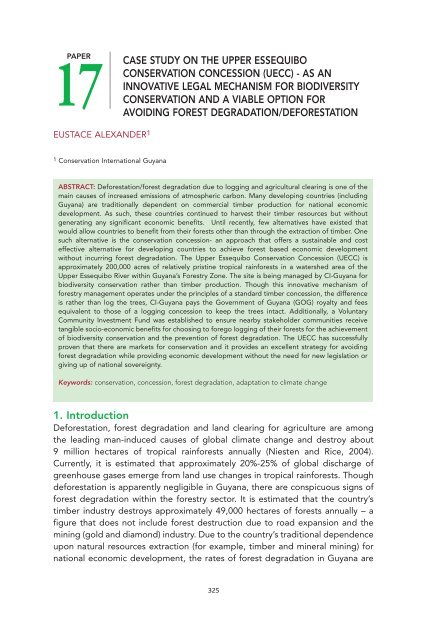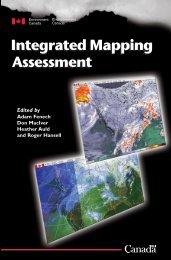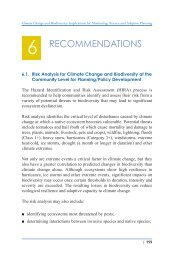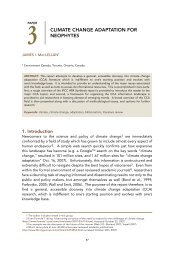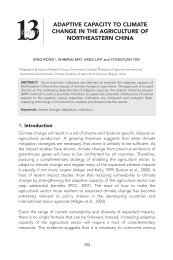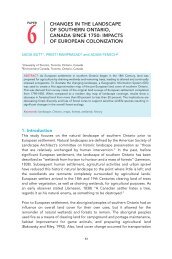Paper 17: Case Study on the Upper Essequibo ... - UPEI Projects
Paper 17: Case Study on the Upper Essequibo ... - UPEI Projects
Paper 17: Case Study on the Upper Essequibo ... - UPEI Projects
Create successful ePaper yourself
Turn your PDF publications into a flip-book with our unique Google optimized e-Paper software.
<str<strong>on</strong>g>17</str<strong>on</strong>g><br />
PAPER<br />
CASE<br />
STUDY ON THE UPPER ESSEQUIBO<br />
CONSERVATION CONCESSION (UECC) - AS AN<br />
INNOVATIVE LEGAL MECHANISM FOR BIODIVERSITY<br />
CONSERVATION AND A VIABLE OPTION FOR<br />
AVOIDING FOREST DEGRADATION/DEFORESTATION<br />
EUSTACE ALEXANDER 1<br />
1 C<strong>on</strong>servati<strong>on</strong> Internati<strong>on</strong>al Guyana<br />
ABSTRACT: Deforestati<strong>on</strong>/forest degradati<strong>on</strong> due to logging and agricultural clearing is <strong>on</strong>e of <strong>the</strong><br />
main causes of increased emissi<strong>on</strong>s of atmospheric carb<strong>on</strong>. Many developing countries (including<br />
Guyana) are traditi<strong>on</strong>ally dependent <strong>on</strong> commercial timber producti<strong>on</strong> for nati<strong>on</strong>al ec<strong>on</strong>omic<br />
development. As such, <strong>the</strong>se countries c<strong>on</strong>tinued to harvest <strong>the</strong>ir timber resources but without<br />
generating any significant ec<strong>on</strong>omic benefits. Until recently, few alternatives have existed that<br />
would allow countries to benefit from <strong>the</strong>ir forests o<strong>the</strong>r than through <strong>the</strong> extracti<strong>on</strong> of timber. One<br />
such alternative is <strong>the</strong> c<strong>on</strong>servati<strong>on</strong> c<strong>on</strong>cessi<strong>on</strong>- an approach that offers a sustainable and cost<br />
effective alternative for developing countries to achieve forest based ec<strong>on</strong>omic development<br />
without incurring forest degradati<strong>on</strong>. The <strong>Upper</strong> <strong>Essequibo</strong> C<strong>on</strong>servati<strong>on</strong> C<strong>on</strong>cessi<strong>on</strong> (UECC) is<br />
approximately 200,000 acres of relatively pristine tropical rainforests in a watershed area of <strong>the</strong><br />
<strong>Upper</strong> <strong>Essequibo</strong> River within Guyana’s Forestry Z<strong>on</strong>e. The site is being managed by CI-Guyana for<br />
biodiversity c<strong>on</strong>servati<strong>on</strong> ra<strong>the</strong>r than timber producti<strong>on</strong>. Though this innovative mechanism of<br />
forestry management operates under <strong>the</strong> principles of a standard timber c<strong>on</strong>cessi<strong>on</strong>, <strong>the</strong> difference<br />
is ra<strong>the</strong>r than log <strong>the</strong> trees, CI-Guyana pays <strong>the</strong> Government of Guyana (GOG) royalty and fees<br />
equivalent to those of a logging c<strong>on</strong>cessi<strong>on</strong> to keep <strong>the</strong> trees intact. Additi<strong>on</strong>ally, a Voluntary<br />
Community Investment Fund was established to ensure nearby stakeholder communities receive<br />
tangible socio-ec<strong>on</strong>omic benefits for choosing to forego logging of <strong>the</strong>ir forests for <strong>the</strong> achievement<br />
of biodiversity c<strong>on</strong>servati<strong>on</strong> and <strong>the</strong> preventi<strong>on</strong> of forest degradati<strong>on</strong>. The UECC has successfully<br />
proven that <strong>the</strong>re are markets for c<strong>on</strong>servati<strong>on</strong> and it provides an excellent strategy for avoiding<br />
forest degradati<strong>on</strong> while providing ec<strong>on</strong>omic development without <strong>the</strong> need for new legislati<strong>on</strong> or<br />
giving up of nati<strong>on</strong>al sovereignty.<br />
Keywords: c<strong>on</strong>servati<strong>on</strong>, c<strong>on</strong>cessi<strong>on</strong>, forest degradati<strong>on</strong>, adaptati<strong>on</strong> to climate change<br />
1. Introducti<strong>on</strong><br />
Deforestati<strong>on</strong>, forest degradati<strong>on</strong> and land clearing for agriculture are am<strong>on</strong>g<br />
<strong>the</strong> leading man-induced causes of global climate change and destroy about<br />
9 milli<strong>on</strong> hectares of tropical rainforests annually (Niesten and Rice, 2004).<br />
Currently, it is estimated that approximately 20%-25% of global discharge of<br />
greenhouse gases emerge from land use changes in tropical rainforests. Though<br />
deforestati<strong>on</strong> is apparently negligible in Guyana, <strong>the</strong>re are c<strong>on</strong>spicuous signs of<br />
forest degradati<strong>on</strong> within <strong>the</strong> forestry sector. It is estimated that <strong>the</strong> country’s<br />
timber industry destroys approximately 49,000 hectares of forests annually – a<br />
figure that does not include forest destructi<strong>on</strong> due to road expansi<strong>on</strong> and <strong>the</strong><br />
mining (gold and diam<strong>on</strong>d) industry. Due to <strong>the</strong> country’s traditi<strong>on</strong>al dependence<br />
up<strong>on</strong> natural resources extracti<strong>on</strong> (for example, timber and mineral mining) for<br />
nati<strong>on</strong>al ec<strong>on</strong>omic development, <strong>the</strong> rates of forest degradati<strong>on</strong> in Guyana are<br />
325
CLIMATE CHANGE AND BIODIVERSITY IN THE AMERICAS<br />
<strong>the</strong>refore likely to accelerate and c<strong>on</strong>sequently, result in <strong>the</strong> destructi<strong>on</strong> of<br />
biodiversity and <strong>the</strong> plundering of crucial envir<strong>on</strong>mental services (for example,<br />
clean air, carb<strong>on</strong> sequestrati<strong>on</strong> and climate regulati<strong>on</strong>) associated with standing<br />
tropical rainforests.<br />
Despite years of internati<strong>on</strong>al efforts to increase global awareness <strong>on</strong> <strong>the</strong> effects<br />
of envir<strong>on</strong>mental destructi<strong>on</strong> and to develop nati<strong>on</strong>al policies and instituti<strong>on</strong>s for<br />
sustainable forest management, many developing countries are still inadequately<br />
equipped to avoid deforestati<strong>on</strong>/forest degradati<strong>on</strong>. Fur<strong>the</strong>rmore, <strong>the</strong>se<br />
developing countries lack mechanisms to capture and commercialize<br />
envir<strong>on</strong>mental services, which possess <strong>the</strong> characteristics of public goods but<br />
have yet to receive an ec<strong>on</strong>omic value in <strong>the</strong> market place. This ec<strong>on</strong>omic<br />
c<strong>on</strong>undrum results in wasteful forest destructi<strong>on</strong> and c<strong>on</strong>tributes significantly to<br />
global emissi<strong>on</strong>s of GHG, due to logging. Therefore <strong>the</strong> provisi<strong>on</strong> of incentives<br />
for developing countries to c<strong>on</strong>serve <strong>the</strong>ir rainforest, its biodiversity and<br />
envir<strong>on</strong>mental services will allow for compensati<strong>on</strong> of <strong>the</strong> opportunity costs for<br />
forgoing logging and will also present cost effective and sustainable opti<strong>on</strong>s to<br />
adapt forestry management to avoid deforestati<strong>on</strong> and/or degradati<strong>on</strong> and<br />
mitigate against climate change.<br />
To create market mechanisms for c<strong>on</strong>servati<strong>on</strong> and to instituti<strong>on</strong>alize<br />
c<strong>on</strong>servati<strong>on</strong> incentives, C<strong>on</strong>servati<strong>on</strong> Internati<strong>on</strong>al (CI) developed and<br />
introduced <strong>the</strong> c<strong>on</strong>cept of a “c<strong>on</strong>servati<strong>on</strong> c<strong>on</strong>cessi<strong>on</strong>,” an innovative approach<br />
that utilizes <strong>the</strong> principles of a standard timber c<strong>on</strong>cessi<strong>on</strong> to achieve biodiversity<br />
c<strong>on</strong>servati<strong>on</strong> outcomes, but also provides an opti<strong>on</strong> for <strong>the</strong> avoidance of<br />
deforestati<strong>on</strong>/forest degradati<strong>on</strong>, while pursuing forest-based nati<strong>on</strong>al ec<strong>on</strong>omic<br />
development. To implement this novel c<strong>on</strong>servati<strong>on</strong> approach, CI through its<br />
Field Office in Guyana (CI-Guyana) applied to <strong>the</strong> Guyana Forestry Commissi<strong>on</strong><br />
(GFC) for a c<strong>on</strong>cessi<strong>on</strong> Lease License, held widespread c<strong>on</strong>sultati<strong>on</strong>s to garner<br />
informed c<strong>on</strong>sensus of stakeholders, built <strong>the</strong> required capacity, and formulated<br />
and implemented a Forest Resources Management Plan (FRMP). This<br />
participatory and transparent approach empowered stakeholders for <strong>the</strong>ir direct<br />
involvement in collaborative management of <strong>the</strong> site.<br />
■ C<strong>on</strong>cept descripti<strong>on</strong><br />
The c<strong>on</strong>cept of a c<strong>on</strong>servati<strong>on</strong> c<strong>on</strong>cessi<strong>on</strong> refers to <strong>the</strong> idea of choosing not to<br />
exercise <strong>the</strong> rights acquired to <strong>the</strong> forests, biodiversity or o<strong>the</strong>r forms of natural<br />
resources. A c<strong>on</strong>servati<strong>on</strong> c<strong>on</strong>cessi<strong>on</strong> may take several forms, but <strong>the</strong> UECC is<br />
modeled after a standard timber c<strong>on</strong>cessi<strong>on</strong> where <strong>the</strong> logging c<strong>on</strong>cessi<strong>on</strong>aire<br />
pays <strong>the</strong> Government of Guyana (GOG) for <strong>the</strong> right to extract timber from an<br />
area within <strong>the</strong> State’s Forest Z<strong>on</strong>e and o<strong>the</strong>r areas of country. The difference is<br />
326
PAPER <str<strong>on</strong>g>17</str<strong>on</strong>g><br />
CASE STUDY ON THE UPPER ESSEQUIBO CONSERVATION CONCESSION (UECC)<br />
AS AN INNOVATIVE LEGAL MECHANISM FOR BIODIVERSITY CONSERVATION AND A<br />
VIABLE OPTION FOR AVOIDING FOREST DEGRADATION/DEFORESTATION<br />
that while <strong>the</strong> logging c<strong>on</strong>cessi<strong>on</strong>aire will log <strong>the</strong> area, <strong>the</strong> c<strong>on</strong>servati<strong>on</strong><br />
c<strong>on</strong>cessi<strong>on</strong>aire pays <strong>the</strong> GOG for <strong>the</strong> forest to remain intact. In o<strong>the</strong>r words,<br />
ra<strong>the</strong>r than paying duties, acreage fees, royalty, etc for <strong>the</strong> extracti<strong>on</strong> of timber<br />
within <strong>the</strong> State’s Forest, CI-Guyana is paying similar fees to <strong>the</strong> GOG through<br />
<strong>the</strong> Guyana Forestry Commissi<strong>on</strong> (GFC) to keep <strong>the</strong> trees standing.<br />
Though a c<strong>on</strong>servati<strong>on</strong> c<strong>on</strong>cessi<strong>on</strong> is currently not recognized as an official<br />
protected area in Guyana, it never<strong>the</strong>less functi<strong>on</strong>s like a standard protected<br />
area by safeguarding <strong>the</strong> forests and its resources from <strong>the</strong> pressures of<br />
extractive ec<strong>on</strong>omic development. In Guyana, <strong>the</strong> UECC serves <strong>the</strong> additi<strong>on</strong>al<br />
functi<strong>on</strong> of buying time for <strong>the</strong> protecti<strong>on</strong> of an area of intact and biologically<br />
important rainforests until it becomes a legally declared protected area. This<br />
mechanism <strong>the</strong>refore not <strong>on</strong>ly offers an alternative to logging in countries<br />
endowed with large areas of intact high biodiversity forests of importance to<br />
c<strong>on</strong>servati<strong>on</strong>, but also provides a vehicle for establishing “anchors” for<br />
biodiversity c<strong>on</strong>servati<strong>on</strong> corridors.<br />
2. The Problem<br />
Logging is <strong>on</strong>e of <strong>the</strong> root causes of deforestati<strong>on</strong> and forest degradati<strong>on</strong> in<br />
Latin America. Guyana and nearby countries are endowed with large expanses of<br />
relatively untouched tropical rainforests, but have traditi<strong>on</strong>ally focused <strong>on</strong><br />
extracti<strong>on</strong> of its timber resources for ec<strong>on</strong>omic development. However, low<br />
prices <strong>on</strong> <strong>the</strong> domestic and global timber markets, low yields per hectare and<br />
relatively high producti<strong>on</strong> costs, have c<strong>on</strong>tributed to a poor financial<br />
performance within <strong>the</strong> timber industry. In spite of this, parcels of State Forests<br />
c<strong>on</strong>tinue to be allocated to logging companies that remove <strong>the</strong> most valuable<br />
timber species, without any generati<strong>on</strong> of significant profits. Simultaneously,<br />
<strong>the</strong>re has been an increasing willingness to pay for c<strong>on</strong>servati<strong>on</strong> in <strong>the</strong><br />
internati<strong>on</strong>al community. Unfortunately, prior to <strong>the</strong> UECC, <strong>the</strong> internati<strong>on</strong>al<br />
d<strong>on</strong>ors did not have a clear market mechanism that could allow <strong>the</strong>m to directly<br />
invest financial resources for biodiversity c<strong>on</strong>servati<strong>on</strong>. As such, <strong>the</strong> GFC did not<br />
have any alternative to <strong>the</strong> allocati<strong>on</strong> of <strong>the</strong> State Forests for commercial timber<br />
producti<strong>on</strong>. The UECC <strong>the</strong>refore provided an innovative and creative way to<br />
harness market forces to achieve biodiversity c<strong>on</strong>servati<strong>on</strong> and presented itself<br />
as an opti<strong>on</strong> to avoid forest degradati<strong>on</strong> within Guyana’s Forestry Sector.<br />
3. Project Implementati<strong>on</strong><br />
At <strong>the</strong> time of project implementati<strong>on</strong>, c<strong>on</strong>servati<strong>on</strong> c<strong>on</strong>cessi<strong>on</strong>s and perhaps,<br />
biodiversity c<strong>on</strong>servati<strong>on</strong> as a whole were relatively new c<strong>on</strong>cepts to Guyana.<br />
327
CLIMATE CHANGE AND BIODIVERSITY IN THE AMERICAS<br />
The GFC had just adopted and implemented <strong>the</strong> principle of Sustainable Forest<br />
Management (SFM) and incorporated it into <strong>the</strong> Nati<strong>on</strong>al Forest Policy.<br />
Simultaneously, Dr. Richard Rice and a group of researchers from CI’s Centre for<br />
Applied Biodiversity Sciences (CI-CABS) were <strong>on</strong> a visit and recognized that SFM<br />
in Guyana will at best allow for l<strong>on</strong>g-term timber supply but with limited<br />
ec<strong>on</strong>omic and ecological benefits. To address this problem, <strong>the</strong>y proposed <strong>the</strong><br />
idea of c<strong>on</strong>servati<strong>on</strong> c<strong>on</strong>cessi<strong>on</strong> to <strong>the</strong> Government and it was accepted. This led<br />
to a series of acti<strong>on</strong>s as described below:<br />
■ Initial C<strong>on</strong>sultati<strong>on</strong> with all stakeholders to evaluate <strong>the</strong><br />
feasibility of <strong>the</strong> idea<br />
After garnering <strong>the</strong> required policy support to initiate activities, CI-Guyana<br />
c<strong>on</strong>sulted with a wide range of potential stakeholders to ascertain <strong>the</strong><br />
acceptability of <strong>the</strong> idea of a c<strong>on</strong>servati<strong>on</strong> c<strong>on</strong>cessi<strong>on</strong>. Through this<br />
comprehensive stakeholder management strategy, CI-Guyana was able to<br />
identify, inform and receive feedback from a wide range of nati<strong>on</strong>al, regi<strong>on</strong>al and<br />
local stakeholders (including communities, Government organizati<strong>on</strong>s, NGOs,<br />
etc). Discussi<strong>on</strong>s were held with <strong>the</strong> Guyana Geology and Mines Commissi<strong>on</strong><br />
(GGMC), <strong>the</strong> Guyana Envir<strong>on</strong>mental Protecti<strong>on</strong> Agency (EPA), Fisheries<br />
Department and <strong>the</strong> Ministry of Agriculture. This was needed because though<br />
<strong>the</strong> C<strong>on</strong>cessi<strong>on</strong> focuses mainly <strong>on</strong> trees and n<strong>on</strong>-timber forest products (NTFP) it<br />
c<strong>on</strong>tains a wide range of resources (for example, wildlife and minerals) that are<br />
of interest to <strong>the</strong>se State Sector Agencies and are not covered by rights under<br />
<strong>the</strong> Forestry Regulati<strong>on</strong>s. C<strong>on</strong>sultati<strong>on</strong>s with <strong>the</strong> Regi<strong>on</strong>al Advisory Committee<br />
(RAC) of <strong>the</strong> Regi<strong>on</strong> Nine (<strong>Upper</strong> Takatu – <strong>Upper</strong> <strong>Essequibo</strong>) Administrati<strong>on</strong> Unit<br />
guided <strong>the</strong> selecti<strong>on</strong> of Apoteri, Rewa and CrashWater (hereafter referred to as<br />
ARC communities) as <strong>the</strong> key stakeholder communities. The sixteen<br />
communities (including <strong>the</strong> ARC communities) in <strong>the</strong> North Rupununi Regi<strong>on</strong> are<br />
all represented by an umbrella community-based NGO registered as <strong>the</strong> North<br />
Rupununi District Development Board (NRDDB). Hence, <strong>the</strong> NRDDB<br />
automatically became <strong>the</strong> principal regi<strong>on</strong>al stakeholder.<br />
For each stage of project development, CI-Guyana sought and gained <strong>the</strong><br />
informed c<strong>on</strong>sensus of <strong>the</strong> principal stakeholders through <strong>the</strong> combinati<strong>on</strong> of<br />
c<strong>on</strong>sultati<strong>on</strong> meetings (Figure 1) with educati<strong>on</strong> and awareness programmes.<br />
Up<strong>on</strong> garnering of <strong>the</strong> support framework for project implementati<strong>on</strong>, a<br />
Guyanese Lawyer was hired to determine <strong>the</strong> compatibility of <strong>the</strong> project with<br />
existing nati<strong>on</strong>al legislati<strong>on</strong>s <strong>on</strong> natural resource management.<br />
328
PAPER <str<strong>on</strong>g>17</str<strong>on</strong>g><br />
CASE STUDY ON THE UPPER ESSEQUIBO CONSERVATION CONCESSION (UECC)<br />
AS AN INNOVATIVE LEGAL MECHANISM FOR BIODIVERSITY CONSERVATION AND A<br />
VIABLE OPTION FOR AVOIDING FOREST DEGRADATION/DEFORESTATION<br />
Photo ©CI-Guyana<br />
FIGURE 1<br />
Community-based stakeholder c<strong>on</strong>sultati<strong>on</strong> meeting.<br />
■ Applied to GFC for a State Forest Exploratory Permit<br />
As is required under <strong>the</strong> nati<strong>on</strong>al Forest Regulati<strong>on</strong>s, an applicati<strong>on</strong> made to <strong>the</strong><br />
GFC for a State Forest Exploratory Permit (SFEP) in May 2000 was accepted five<br />
m<strong>on</strong>ths later, but <strong>on</strong>ly <strong>on</strong>e-fifth (approximately 200,000 acres) of <strong>the</strong> area applied<br />
for was received. This permit allows a prospective timber c<strong>on</strong>cessi<strong>on</strong>aire to<br />
execute feasibility studies and baseline analyses, all of which must be completed<br />
within three years in order to receive <strong>the</strong> lease agreement – Timber Sales<br />
Agreement (TSA).<br />
■ Established formal partnerships with Government Agencies<br />
CI-Guyana entered into a formal Memorandum of Understanding with <strong>the</strong> GOG<br />
for <strong>the</strong> sharing and wide distributi<strong>on</strong> of any informati<strong>on</strong> that may be generated<br />
from research activities undertaken at <strong>the</strong> site. A commitment for a closer work<br />
relati<strong>on</strong>ship was also formalized though a MOU with <strong>the</strong> University of Guyana (UG).<br />
■ Baseline Analyses<br />
A Social Impact Assessment (SIA) was c<strong>on</strong>ducted in <strong>the</strong> ARC communities to<br />
determine socio-ec<strong>on</strong>omic impacts of <strong>the</strong> c<strong>on</strong>cessi<strong>on</strong>. Because <strong>the</strong> project is not<br />
intended to have any negative envir<strong>on</strong>mental affects, <strong>the</strong> Guyana Envir<strong>on</strong>mental<br />
Protecti<strong>on</strong> Agency (EPA) waived <strong>the</strong> need for an Envir<strong>on</strong>mental Impacts<br />
Assessment (EIA). The draft SIA report was submitted to EPA and <strong>the</strong><br />
communities for feedback before being finalized. Up<strong>on</strong> approval of <strong>the</strong> report,<br />
copies were widely distributed am<strong>on</strong>g all stakeholders and partners.<br />
329
CLIMATE CHANGE AND BIODIVERSITY IN THE AMERICAS<br />
O<strong>the</strong>r initial analyses c<strong>on</strong>ducted were:<br />
• A preliminary rec<strong>on</strong>naissance and geo-referencing of <strong>the</strong> proposed site; and<br />
• A vegetati<strong>on</strong> classificati<strong>on</strong> based <strong>on</strong> video graphic surveys.<br />
■ Built local capacity for co-management<br />
Management of <strong>the</strong> UECC required active participati<strong>on</strong> of <strong>the</strong> stakeholder<br />
communities, including a core team for l<strong>on</strong>g-term m<strong>on</strong>itoring. To build <strong>the</strong><br />
relevant local capacity CI-Guyana entered into an Agreement with <strong>the</strong> Iwokrama<br />
Centre for Research and Training (ICRT) to train four residents of <strong>the</strong> ARC<br />
communities for two years. Under <strong>the</strong> Agreement CI-Guyana was both a sp<strong>on</strong>sor<br />
(c<strong>on</strong>tributing <strong>on</strong>e-third of total cost of training programme) and client to <strong>the</strong><br />
Ranger Training Programme.<br />
■ Preparati<strong>on</strong> of a FRMP for first five years of management<br />
Data emerging from <strong>the</strong> baseline analyses and from regi<strong>on</strong>al and community<br />
c<strong>on</strong>sultati<strong>on</strong>s were used to guide <strong>the</strong> development of <strong>the</strong> first five-year FRMP.<br />
The draft FRMP was presented for feedback at nati<strong>on</strong>al, regi<strong>on</strong>al and local<br />
c<strong>on</strong>sultati<strong>on</strong> meetings. Many of <strong>the</strong> State Sector Agencies, NGOs and o<strong>the</strong>r<br />
partners including <strong>the</strong> EPA were also asked to review and comment <strong>on</strong> its<br />
c<strong>on</strong>tents. After receipt of widespread feedback, <strong>the</strong> final draft was presented at<br />
ano<strong>the</strong>r Nati<strong>on</strong>al C<strong>on</strong>sultati<strong>on</strong> Workshop in <strong>the</strong> capital city of Georgetown.<br />
GFC’s approval of <strong>the</strong> FRMP was received in 2002 March and discussed with <strong>the</strong><br />
ARC communities a few weeks later.<br />
■ Applied to GFC for a Timber Sales Agreement (TSA) and <strong>the</strong> EPA for an<br />
Envir<strong>on</strong>mental Permit<br />
Applicati<strong>on</strong> to <strong>the</strong> GFC for <strong>the</strong> TSA was made in March 2002 and so<strong>on</strong> after,<br />
negotiati<strong>on</strong>s commenced <strong>on</strong> <strong>the</strong> types and magnitude of payments to be made<br />
for <strong>the</strong> UECC. CI-Guyana and <strong>the</strong> GFC reached a negotiated agreement <strong>on</strong> <strong>the</strong><br />
annual royalty fees, but as stipulated in <strong>the</strong> nati<strong>on</strong>al forestry Regulati<strong>on</strong>s - <strong>the</strong><br />
acreage fees remained at 0.15 USD per acre. The GFC also requested a <strong>on</strong>e-off<br />
payment of a Performance B<strong>on</strong>d. Additi<strong>on</strong>ally, <strong>the</strong> EPA requested an annual<br />
Envir<strong>on</strong>mental Permit Fee as a safeguard for <strong>the</strong> project.<br />
On <strong>the</strong> <str<strong>on</strong>g>17</str<strong>on</strong>g> th July 2002, CI-Guyana and <strong>the</strong> GOG signed <strong>the</strong> Lease Agreement for<br />
approximately 200,000 acres of relatively pristine rainforest <strong>the</strong>reby establishing<br />
<strong>the</strong> world’s first c<strong>on</strong>servati<strong>on</strong> c<strong>on</strong>cessi<strong>on</strong>. The TSA provides CI-Guyana with a<br />
30-year lease to a porti<strong>on</strong> of State Forest within a watershed area of <strong>the</strong> upper<br />
<strong>Essequibo</strong> River for c<strong>on</strong>servati<strong>on</strong> management ra<strong>the</strong>r than timber producti<strong>on</strong>.<br />
This historic signing cerem<strong>on</strong>y occurred at <strong>the</strong> Office of <strong>the</strong> President and<br />
330
PAPER <str<strong>on</strong>g>17</str<strong>on</strong>g><br />
CASE STUDY ON THE UPPER ESSEQUIBO CONSERVATION CONCESSION (UECC)<br />
AS AN INNOVATIVE LEGAL MECHANISM FOR BIODIVERSITY CONSERVATION AND A<br />
VIABLE OPTION FOR AVOIDING FOREST DEGRADATION/DEFORESTATION<br />
signaled <strong>the</strong> implementati<strong>on</strong> of an innovative mechanism for forest management<br />
that will not <strong>on</strong>ly allow for biodiversity c<strong>on</strong>servati<strong>on</strong> and socio-ec<strong>on</strong>omic<br />
development, but will also avoid forest degradati<strong>on</strong> and c<strong>on</strong>tribute to <strong>the</strong><br />
reducti<strong>on</strong> of climate change.<br />
■ C<strong>on</strong>ducted an inventory of timber stocks in <strong>the</strong> c<strong>on</strong>cessi<strong>on</strong><br />
So<strong>on</strong> after receipt of <strong>the</strong> TSA, an inventory of <strong>the</strong> commercial timber species was<br />
c<strong>on</strong>ducted at <strong>the</strong> site. The aims of <strong>the</strong> inventory were to upgrade <strong>the</strong> nati<strong>on</strong>al<br />
forest resources map and to receive informati<strong>on</strong> required to guide <strong>the</strong><br />
development of a valuati<strong>on</strong> model to achieve a more realistic value of <strong>the</strong> timber<br />
resources at <strong>the</strong> site. At that time, <strong>the</strong> development of a valuati<strong>on</strong> model to<br />
accurately determine royalty payments was being c<strong>on</strong>sidered, but as stated in<br />
<strong>the</strong> previous paragraph, CI-Guyana and <strong>the</strong> GFC opted for negotiated and<br />
mutually agreed royalty payments.<br />
The fact that royalty payments were negotiated, it infers that <strong>the</strong> GFC is probably<br />
receiving more than <strong>the</strong> actual value of standing timber at <strong>the</strong> UECC.<br />
■ Implemented a Voluntary Community Investment Fund (VCIF)<br />
In 2002 August, a Voluntary Community Investment Fund (VCIF) was<br />
implemented to provide for socio-ec<strong>on</strong>omic development to <strong>the</strong> ARC<br />
communities for forgoing employment and o<strong>the</strong>r benefits that might have<br />
existed if logging was being d<strong>on</strong>e at <strong>the</strong> site. Because <strong>the</strong> NRDDB represents <strong>the</strong><br />
interest of <strong>the</strong> stakeholder communities, an MOU was signed between CI-<br />
Guyana and <strong>the</strong> NRDDB for co-management of <strong>the</strong> VCIF.<br />
4. Results<br />
The experience so far provided by <strong>the</strong> UECC has c<strong>on</strong>firmed that <strong>the</strong> idea of using<br />
“c<strong>on</strong>servati<strong>on</strong> c<strong>on</strong>cessi<strong>on</strong>” as an opti<strong>on</strong> to avoid forest degradati<strong>on</strong>/<br />
deforestati<strong>on</strong> is quite viable. The UECC provides <strong>the</strong> GOG with a win-win<br />
opportunity to retain sovereignty of its forests and exercise a nati<strong>on</strong>al<br />
resp<strong>on</strong>sibility to c<strong>on</strong>serve its natural resources, while at <strong>the</strong> same time<br />
generating financial benefits to support nati<strong>on</strong>al development programmes. The<br />
UECC is also ano<strong>the</strong>r dem<strong>on</strong>strati<strong>on</strong> of Guyana’s commitment to <strong>the</strong> C<strong>on</strong>venti<strong>on</strong><br />
of Biological Diversity (CBD) for <strong>the</strong> promoti<strong>on</strong> of biodiversity c<strong>on</strong>servati<strong>on</strong>. This<br />
is a significant achievement for <strong>the</strong> country, which is still in <strong>the</strong> process of<br />
developing legislati<strong>on</strong> for a nati<strong>on</strong>al protected areas system. Therefore, in <strong>the</strong><br />
absence of nati<strong>on</strong>al legal mechanisms for protected areas, <strong>the</strong> UECC resulted in<br />
structured and effective c<strong>on</strong>servati<strong>on</strong> of 200,000 acres of intact (Figure 2) and<br />
biological important rainforest.<br />
331
CLIMATE CHANGE AND BIODIVERSITY IN THE AMERICAS<br />
Photo ©Save Your World LLC.<br />
FIGURE 2<br />
Aerial view of secti<strong>on</strong> of UECC.<br />
Through <strong>the</strong> UECC a platform is now created for Guyana to become a<br />
beneficiary of carb<strong>on</strong> credits and/or o<strong>the</strong>r payment schemes for <strong>the</strong> provisi<strong>on</strong> of<br />
ecological goods and services such as clean air, quality freshwater and climate<br />
regulati<strong>on</strong>. While countries (like Guyana) with negligible rates of deforestati<strong>on</strong><br />
and intact high biodiversity-value rainforests wait up<strong>on</strong> <strong>the</strong> proposed<br />
modificati<strong>on</strong>s to <strong>the</strong> Kyoto Protocol, <strong>the</strong> c<strong>on</strong>servati<strong>on</strong> c<strong>on</strong>cessi<strong>on</strong> presents<br />
opportunities for benefits from o<strong>the</strong>r forms of c<strong>on</strong>servati<strong>on</strong> incentive schemes.<br />
The remote locati<strong>on</strong> and management regime allowed <strong>the</strong> UECC to provide<br />
niche refugia for many species shy of <strong>the</strong> more accessible and impacted places.<br />
Though <strong>the</strong> biodiversity of <strong>the</strong> UECC is not yet fully understood, many species<br />
ei<strong>the</strong>r endemic to Guyana or globally endangered are supported by <strong>the</strong> site, for<br />
example, <strong>the</strong> giant river otter (Pter<strong>on</strong>ura brasiliensis), giant armadillo (Priod<strong>on</strong>tes<br />
maximus), black caiman (Melanosuchus niger), jaguar (Pan<strong>the</strong>ra <strong>on</strong>ca), and giant<br />
anteater (Myrmecophaga tridactyla). There is also a unique reef of <strong>the</strong> endemic<br />
greenheart (Cholorcardium rodiei) - Guyana’s most valuable commercial timber<br />
species. According to <strong>the</strong> GFC, this reef is probably <strong>the</strong> limits of <strong>the</strong> greenheart<br />
distributi<strong>on</strong> in Guyana.<br />
Through <strong>the</strong> UECC <strong>the</strong> image of Guyana’s forestry sector has also been<br />
enhanced. In fact, <strong>the</strong> GFC globally advertises <strong>the</strong> project to illustrate its<br />
commitment to SFM and to dem<strong>on</strong>strate that ec<strong>on</strong>omic and ecological gains can<br />
332
PAPER <str<strong>on</strong>g>17</str<strong>on</strong>g><br />
CASE STUDY ON THE UPPER ESSEQUIBO CONSERVATION CONCESSION (UECC)<br />
AS AN INNOVATIVE LEGAL MECHANISM FOR BIODIVERSITY CONSERVATION AND A<br />
VIABLE OPTION FOR AVOIDING FOREST DEGRADATION/DEFORESTATION<br />
be accrued through <strong>the</strong> avoidance of destructive forest development. At<br />
present, <strong>the</strong> UECC allows Guyana (through <strong>the</strong> GFC) to receive a steady flow of<br />
revenue for <strong>the</strong> protecti<strong>on</strong> of standing forests ra<strong>the</strong>r than from <strong>the</strong> extracti<strong>on</strong> of<br />
trees for lumber.<br />
The local communities have also dem<strong>on</strong>strated str<strong>on</strong>g support for <strong>the</strong> UECC -<br />
mainly because of <strong>the</strong>ir dependence <strong>on</strong> its resources for <strong>the</strong>ir livelihoods and<br />
<strong>the</strong>ir desire to secure <strong>the</strong>ir nearby forests from <strong>the</strong> perils of destructive<br />
development and still receive socio-ec<strong>on</strong>omic benefits. Since implementati<strong>on</strong>,<br />
<strong>the</strong> local communities have expressed satisfacti<strong>on</strong> with <strong>the</strong> project, which allows<br />
<strong>the</strong>m to keep <strong>the</strong> trees standing ra<strong>the</strong>r than being logged, c<strong>on</strong>serve <strong>the</strong>ir food<br />
resources, maintain traditi<strong>on</strong>al practices and still receive employment, training<br />
and community development. To date, funds disbursed under VCIF have<br />
c<strong>on</strong>tributed significantly to <strong>the</strong>ir welfare and livelihoods. For instance, a vibrant<br />
sheep and mutt<strong>on</strong> producti<strong>on</strong> project was established at Apoteri, eco-lodges<br />
were c<strong>on</strong>structed for Rewa (Figure 3) and CrashWater received a sewing and<br />
craft centre. These communities collaborated with <strong>the</strong> NRDDB to identify and<br />
c<strong>on</strong>duct feasibility analyses of <strong>the</strong> projects prior to submissi<strong>on</strong> of proposals to<br />
<strong>the</strong> VCIF Steering Committee. In additi<strong>on</strong> to employment received through <strong>the</strong><br />
VCIF, <strong>the</strong> communities also benefit annually from temporary sources of<br />
employment (<strong>on</strong> average 20 pers<strong>on</strong>s per year) for <strong>the</strong> implementati<strong>on</strong> of <strong>on</strong>-site<br />
project activities. The four graduated Rangers (who are residents of <strong>the</strong> ARC<br />
Photo ©CI-Guyana<br />
FIGURE 3<br />
Edward’s Eco-lodges at Rewa Village.<br />
333
CLIMATE CHANGE AND BIODIVERSITY IN THE AMERICAS<br />
communities) are permanently employed by CI-Guyana. Collectively, <strong>the</strong>y<br />
manage <strong>the</strong> Field Base at Apoteri and routinely m<strong>on</strong>itor <strong>the</strong> site to ensure its<br />
biological integrity is not being jeopardized.<br />
Since its implementati<strong>on</strong>, <strong>the</strong> UECC has influenced similar initiatives in o<strong>the</strong>r<br />
countries such as Peru, Guatemala, Democratic Republic of C<strong>on</strong>go and Sierra<br />
Le<strong>on</strong>e.<br />
5. C<strong>on</strong>clusi<strong>on</strong><br />
The UECC has successfully proven that c<strong>on</strong>servati<strong>on</strong> c<strong>on</strong>cessi<strong>on</strong>s could be<br />
modeled after standard timber c<strong>on</strong>cessi<strong>on</strong>s to safeguard pristine high<br />
biodiversity value rainforest from forest degradati<strong>on</strong> and deforestati<strong>on</strong>. Thus, it<br />
is an excellent strategy to achieve biodiversity c<strong>on</strong>servati<strong>on</strong>, avoid forest<br />
degradati<strong>on</strong> and promote ec<strong>on</strong>omic development at both nati<strong>on</strong>al and local<br />
levels. It presents a win-win opportunity for <strong>the</strong> GOG to enter into transacti<strong>on</strong>s<br />
with a willing buyer of forest c<strong>on</strong>servati<strong>on</strong> without <strong>the</strong> need to alter existing<br />
legislati<strong>on</strong> or surrender sovereignty over <strong>the</strong> country’s natural resources.<br />
Successful implementati<strong>on</strong> was due to a well structured stakeholder<br />
management strategy that included <strong>the</strong> combinati<strong>on</strong> of c<strong>on</strong>servati<strong>on</strong> educati<strong>on</strong><br />
and awareness programmes with c<strong>on</strong>sultati<strong>on</strong> meetings. This approach allowed<br />
for transparency and total participati<strong>on</strong> <strong>the</strong>reby giving all stakeholders a direct<br />
stake in c<strong>on</strong>servati<strong>on</strong> management of <strong>the</strong> site<br />
At present a few limitati<strong>on</strong>s/c<strong>on</strong>straints to Guyana’s model of a c<strong>on</strong>servati<strong>on</strong><br />
c<strong>on</strong>cessi<strong>on</strong> are as follows:<br />
• The current nati<strong>on</strong>al Forest Act under which <strong>the</strong> UECC was allocated <strong>on</strong>ly<br />
provides <strong>the</strong> c<strong>on</strong>cessi<strong>on</strong>aire rights to “forest produce,” that is, timber and<br />
o<strong>the</strong>r botanical n<strong>on</strong>-timber forest products. So far, CI-Guyana has received <strong>the</strong><br />
assurance and support of <strong>the</strong>se State Instituti<strong>on</strong>s to withdraw any interest in<br />
land uses that are incompatible to <strong>the</strong> goals and objectives of <strong>the</strong> UECC;<br />
• Due to an unexpected decrease in <strong>the</strong> availability of funds for project<br />
management CI as a not-for-profit NGO was compelled to aggressively<br />
fundraise to sustain <strong>the</strong> payments of annual acreage fees and royalty. To date,<br />
<strong>the</strong> UECC has been financed by <strong>the</strong> Global C<strong>on</strong>servati<strong>on</strong> Fund and Save Your<br />
World, an American-based company that specializes in organic cosmetics and<br />
d<strong>on</strong>ates a percentage of each product sold to finance <strong>the</strong> c<strong>on</strong>cessi<strong>on</strong> fees;<br />
• The current global principles of <strong>the</strong> Kyoto Protocol inhibit <strong>the</strong> UECC from<br />
receiving real cash benefits for reduced emissi<strong>on</strong>s of carb<strong>on</strong> due to avoided<br />
334
PAPER <str<strong>on</strong>g>17</str<strong>on</strong>g><br />
CASE STUDY ON THE UPPER ESSEQUIBO CONSERVATION CONCESSION (UECC)<br />
AS AN INNOVATIVE LEGAL MECHANISM FOR BIODIVERSITY CONSERVATION AND A<br />
VIABLE OPTION FOR AVOIDING FOREST DEGRADATION/DEFORESTATION<br />
deforestati<strong>on</strong>/forest degradati<strong>on</strong> (RED/D). To counter, CI has adopted and<br />
instituti<strong>on</strong>alized a policy <strong>on</strong> climate change that includes avoided<br />
deforestati<strong>on</strong>. Simultaneously, CI through CI-Guyana is collaborating with <strong>the</strong><br />
GOG <strong>on</strong> global policy initiatives to ensure that <strong>the</strong> UECC and Guyana as a<br />
whole benefit from carb<strong>on</strong> trading through <strong>the</strong> avoidance of forest<br />
degradati<strong>on</strong>.<br />
Though <strong>the</strong>re are c<strong>on</strong>straints, <strong>the</strong> benefits of <strong>the</strong> UECC outweigh <strong>the</strong> limitati<strong>on</strong>s.<br />
In c<strong>on</strong>clusi<strong>on</strong>, <strong>the</strong> project allows c<strong>on</strong>servati<strong>on</strong> outcomes to be achieved, provides<br />
an opti<strong>on</strong> for <strong>the</strong> avoidance of forest degradati<strong>on</strong> to reduce emissi<strong>on</strong>s of<br />
atmospheric carb<strong>on</strong>, promotes socio-ec<strong>on</strong>omic development and will ultimately<br />
c<strong>on</strong>tribute to <strong>the</strong> preventi<strong>on</strong> of global climate change.<br />
Acknowledgements<br />
The author wishes to extend grateful appreciati<strong>on</strong> to Dr. Richard Rice and a few<br />
an<strong>on</strong>ymous reviewers for <strong>the</strong>ir comments <strong>on</strong> <strong>the</strong> manuscript.<br />
References<br />
Osborne, T. and Kiker, C., 2002: Carb<strong>on</strong> Offsets as an ec<strong>on</strong>omic alternative to large-scale<br />
logging: a case study in Guyana. Ecological Ec<strong>on</strong>omics (52) 2005. 481-496.<br />
Puspitasari, S., 2003: C<strong>on</strong>servati<strong>on</strong> C<strong>on</strong>cessi<strong>on</strong>s in Ind<strong>on</strong>esia. An investigati<strong>on</strong> of <strong>the</strong>ir<br />
potential. Master’s of Science <strong>the</strong>sis, University of Eat Anglia, Norwich.<br />
Niesten, E. and Rice, R., 2004: Sustainable Forest Management and C<strong>on</strong>servati<strong>on</strong><br />
Incentives Agreements. Internati<strong>on</strong>al Forestry Review (6) 2004. 56-60.<br />
Rice, R., 2003: C<strong>on</strong>servati<strong>on</strong> C<strong>on</strong>cessi<strong>on</strong>s – C<strong>on</strong>cept Descripti<strong>on</strong>. <str<strong>on</strong>g>Paper</str<strong>on</strong>g> presented at V th<br />
World Parks C<strong>on</strong>gress. Durban, South Africa.<br />
335


